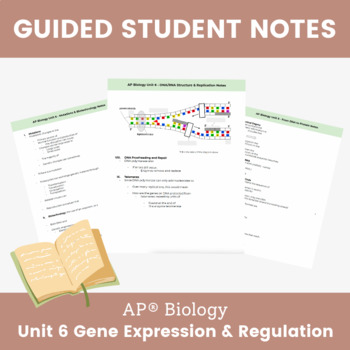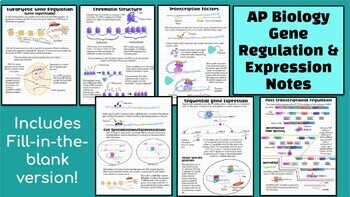Ap Biology Chapter 15 Regulation Of Gene Expression
Regulation of Gene Expression in AP Biology: Exploring the Intricacies of Genetic Control
Welcome to a fascinating journey into the world of gene expression regulation! In this AP Biology Chapter 15, we delve into the mechanisms that determine when and how genes are activated or repressed. Gene expression plays a pivotal role in shaping an organism's traits, behaviors, and overall functionality. Through this comprehensive guide, we aim to unfold the intricate web of gene regulation, shedding light on various aspects of this captivating process.
Understanding Gene Expression Regulation

Gene expression regulation is a complex system that determines how, when, and where genes are activated or suppressed in an organism. It plays a crucial role in developmental processes, response to environmental cues, and maintenance of homeostasis. Understanding the underlying mechanisms of gene expression regulation is vital to comprehending the intricacies of life itself.
Exploring Eukaryotic Gene Regulation

Eukaryotic gene regulation is a multifaceted process involving various levels of control. From transcriptional regulation to post-translational modifications, this mechanism enables cells to fine-tune gene expression to suit their needs. Through epigenetics, enhancers, repressors, and other intricacies, eukaryotic organisms achieve precise control over their gene expression profiles.
Unraveling the Mysteries of Transcription Factors

Transcription factors are pivotal players in gene expression regulation. Acting as molecular switches, these proteins bind to specific DNA sequences and either activate or repress gene transcription. Their ability to initiate or inhibit the recruitment of RNA polymerase is crucial in determining the expression levels of various genes. Understanding the role of transcription factors is key to comprehending the complexities of genetic control.
Frequently Asked Questions (FAQ)
1. What is gene expression?
Gene expression refers to the process by which information encoded in a gene is used to guide the synthesis of a functional gene product, such as a protein or RNA molecule.
2. Why is gene expression regulation important?
Gene expression regulation allows organisms to respond to internal and external cues, adapt to changing environments, maintain cellular homeostasis, and develop specialized tissues and organs.
3. How is gene expression regulated in eukaryotic organisms?
Eukaryotic gene expression regulation involves multiple levels, including epigenetic modifications, transcriptional regulation, post-transcriptional processing, and post-translational modifications. These mechanisms work together to tightly control when and how genes are expressed.
4. What are transcription factors and how do they regulate gene expression?
Transcription factors are proteins that bind to specific DNA sequences and control the rate of gene transcription. They can either activate or repress transcription by recruiting or inhibiting the recruitment of RNA polymerase to the gene's promoter region.
5. Are there any environmental factors that can influence gene expression?
Yes, various environmental factors, such as temperature, light, hormones, and nutrients, can impact gene expression. These external cues can alter the activity of transcription factors or modify epigenetic marks, leading to changes in gene expression patterns.
Whether you are familiar with the basics of gene regulation or just beginning to explore this captivating field, this guide aims to provide you with valuable insights into the intricacies of genetic control. Remember, gene expression regulation is a fascinating area of study that continues to unravel new discoveries and unlock the secrets of life itself.
AP Biology Eukaryotic Gene Regulation & Gene Expression Notes | TPT
 Image Source : www.teacherspayteachers.com
Image Source : www.teacherspayteachers.com AP® Biology Unit 6 Gene Expression & Regulation Activities & Resources
 Image Source : www.teachonamission.com
Image Source : www.teachonamission.com AP Biology Eukaryotic Gene Regulation & Gene Expression Notes | TPT
 Image Source : www.teacherspayteachers.com
Image Source : www.teacherspayteachers.com AP Biology Chapter 15 The Chromosome Theory Of Inheritance - [PPT
 Image Source : vdocument.in
Image Source : vdocument.in AP® Biology Unit 6 Gene Expression & Regulation Guided Student Notes
 Image Source : www.teacherspayteachers.com
Image Source : www.teacherspayteachers.com AP® Biology Unit 6 Gene Expression & Regulation Activities & Resources
 Image Source : www.teachonamission.com
Image Source : www.teachonamission.com AP Biology Eukaryotic Gene Regulation & Gene Expression Notes | TPT
 Image Source : www.teacherspayteachers.com
Image Source : www.teacherspayteachers.com AP Biology Eukaryotic Gene Regulation & Gene Expression Notes | TPT
 Image Source : www.teacherspayteachers.com
Image Source : www.teacherspayteachers.com Ap biology eukaryotic gene regulation & gene expression notes. Ap biology eukaryotic gene regulation & gene expression notes. Ap® biology unit 6 gene expression & regulation activities & resources. Ap® biology unit 6 gene expression & regulation guided student notes. Ap biology eukaryotic gene regulation & gene expression notes